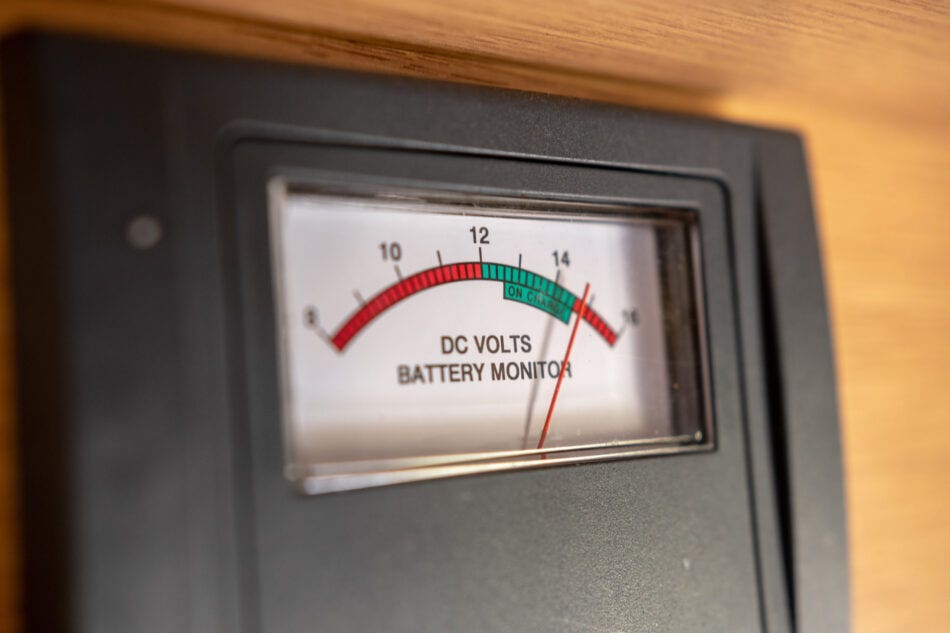Maintaining your RV is important to save you money long term and keep your RV operating white you camp. In this article, we’ll walk you through how to maintain RV batteries. Keep in mind there are different types of RV batteries, so make sure you know which type your RV has. Check your RV manual for details on battery type and maintenance.
Safety When Performing RV Battery Maintenance
Unless you’re just doing a visual check, make sure you’re carrying out RV battery maintenance safely:
- Disconnect the battery from all power sources.
- Wear rubber-soled shoes or stand on a rubber mat.
- Wear gloves (preferably thicker rubber).
- Wear goggles.
- Always do a visual check of the battery for any issues like fraying or split wire casings.
- Only ever use distilled water.
- Work in a well-ventilated area.
If you’re ever in doubt, seek a professional’s help.
Basic RV Battery Maintenance
A quick summary of basic RV battery maintenance is:
- Do a visual check for issues like fraying or split wire casings, corrosion, cracks and leaks.
- Check your battery’s power levels. A 12-volt battery should measure at 12.7 volts – if it’s lower, charge it up and if it’s higher, use power in your RV until it’s back to 12.7 volts.
- Check the fluids in your battery and top up with distilled water if necessary.
- Remove any corrosion.
- Inspect battery connections and tighten if needed.
You should check your battery every month for 90 days. If your RV is in storage, consider removing the battery as it should be stored somewhere warm, off the ground and on top of cardboard if possible. You should use a trickle charger to ensure the battery is kept charged (or charge it when you check on it if needed).
Visual Inspection of Your RV Battery
The first step of RV battery maintenance is to do a visual inspection of your RV battery. You are looking for:
- Fraying or split wire casing.
- Cracks on the battery housing.
- Leaks of any fluids.
- Corrosion or sulfidation (blue or white powder).
- Any other abnormalities.
If you can’t see any of these problems, you’ll check the charge of the battery next.
Power Levels for an RV Battery
It’s important to keep a 12-volt RV battery charged between 12.2 and 12.7 volts. If your battery is below or higher than this voltage, it can cause decreased battery performance and lifespan. There are multiple ways to check the charge but a voltmeter is usually the easiest.
You may want to install a trickle charger or one with multiple settings to allow you to properly keep your RV charged whether you’re using it or not.
RV Battery Fluids
Over time, RV batteries will lose the water in their cells through charging or evaporation. If the water completely disappears, it can kill your battery. Low levels of water can also shorten your battery’s lifespan due to sulfation.
Regularly check and maintain the water level in your RV batteries to ensure it keeps working for their full life span. You should only fill the cells until the cell plates are covered (there may be a marking). Don’t overfill!
AGM or gel-based batteries do not have water and do not require this maintenance. Make sure you know which type of RV battery you have.
Dealing with Corrosion
If you spot corrosion (usually a blue or white powder), it’s important to remove it. It can cause poor connections and cause a motorhome to not start.
To treat, you simply use a wire brush to scrub the corrosion away. Make sure you’re wearing gloves and goggles and have the battery disconnected from all power sources.
You can use a baking soda and water mixture to treat and prevent corrosion as well. Mix ¼ cup of baking soda with 1.5 cups of water (1:6 ratio) and spray the terminals. Let it stand for at least 5 minutes then rinse with water. If there is corrosion, apply the solution, let it stand for 10 minutes and gently scrub with the wire brush.
Inspect the RV Battery Connections
Connections can loosen with movement or if you take your battery when your RV is in storage. Check that all the connections are tight. If they’re loose, you can use a Philips head screwdriver to tighten them. Be careful not to overtighten.
RV Battery Storage
It’s important that you check your RV battery every month to 90 days when your RV is in storage. You should ensure your battery is in good condition and properly charged. A trickle charger can help keep your battery charged without overcharging it (some chargers have a float charge or maintenance charge that accomplishes the same thing).
If you cannot charge your battery or check it regularly while your RV is in storage you may want to take the battery with you. It should be stored somewhere warm, off the ground, and on cardboard. This can make it easier to keep it properly charged.
Why Battery Maintenance is Important
Without a working battery, your RV’s appliances, lights and other features won’t work. Proper maintenance will ensure your RV’s battery will keep working and have a longer overall lifespan. As a new battery can cost $150 or more, that maintenance will pay off!
RV insurance doesn’t cover maintenance issues. If your RV battery fails due to a lack of maintenance or a mistake like undercharging it, you likely won’t be covered.
This maintenance is pretty easy to take care of for most RV owners, although you can also get a professional to check your batteries and take care of regular maintenance.

